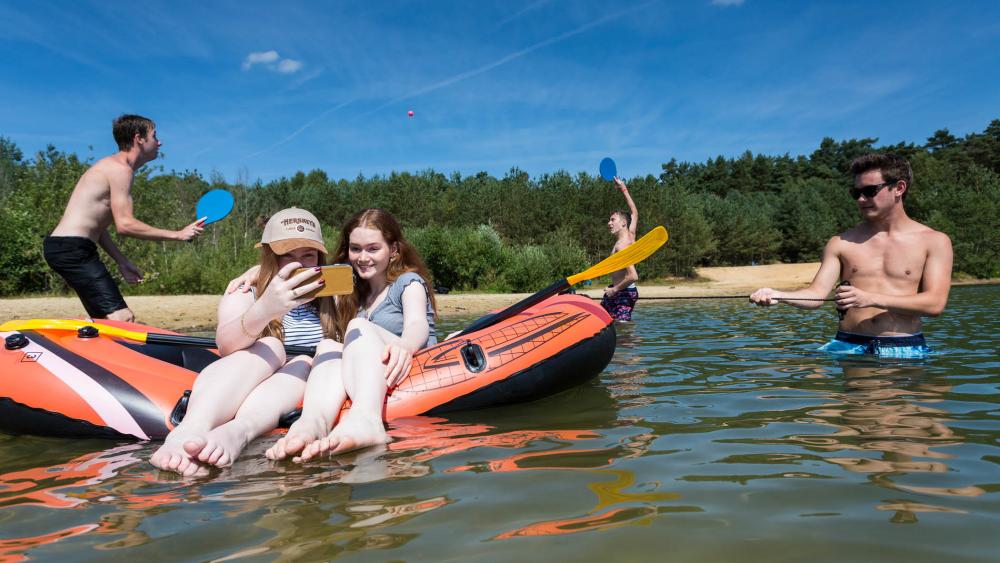
Scarcely any research has been undertaken on many different recreational uses of water. | Photo: Florian Möllers/AVN
Dr. Christian Wolter is in charge of the cross-cutting reaearch domain 3 at IGB. | Photo: Andy Küchenmeister/IGB
Mr. Venohr, Mr. Wolter, in your latest project – AQUATAG – you explore the extent to which human recreation affects freshwaters. How did this come about?
Christian Wolter: Anthropogenic effects on freshwaters are an important aspect of our research. In the past, however, we focused mainly on commercial use, i.e. impairments due to shipping or the input of agricultural nutrients. Regarding the question of how to revitalise freshwaters, recreational use automatically became the focus of attention – after all, motorboats are also used privately…
Markus Venohr: … and then there are also canoeists, dog-walkers and swimmers, all of whom use lakes and rivers for different purposes. All in all, recreational activities place considerable pressure on freshwaters, particularly in cities; as yet, however, we know too little about this phenomenon. What conditions determine the number of people who go to rivers and lakes at particular times? There is very little data on this; and the information that is available, such as the annual average number of bathers, is inappropriate for identifying use peaks. Although peaks usually only occur on a few days each year, they may, under certain circumstances, have a considerable and long-lasting impact on ecology.
What distinguishes such peaks, and why do they have such an impact on freshwaters?
MV: Bathing waters in particular are very popular on hot, sunny days; further the number of visitors is much higher on weekends and during the holidays compared to on working days. We want to find out at which point the burden becomes problematic for the ecology of freshwaters.
CW: In this context, we are also interested in the question of any feedback effects there may be between use and burden. If large numbers of people visit a bathing lake and its ecosystem suffers, will this affect the use of the lake? Surveys have revealed that visitors prefer moderately damaged ecosystems – such as a “tidy” beach with little plant cover and no aquatic plants on the shoreline – where user satisfaction is much higher than with near natural conditions.
Dr. Markus Venohr leads the new project AQUATAG, in which researchers investigate the effects of recreational uses on water bodies. | Photo: Andy Küchenmeister/IGB
What do bathers consider to be particularly important?
MV: Those wishing to swim attach great importance to clear water; waste was also often mentioned as a disturbing factor. Interestingly, other users are likewise undesirable. If a bathing area is overcrowded, this may be considered more annoying than waste or other disturbances. However, preferences differ depending on the type of user. For example, a good water quality means something completely different to anglers; they prefer murkier, i.e. nutrient-rich, water where fish are able to thrive. Boaters, on the other hand, prefer to see less aquatic plants. In any case, the environmental burden on freshwaters sets in long before recreational users perceive any changes. We are interested in such threshold values: what level of use pressure results in the permanent impairment of ecosystems?
CW: We have already managed to define such a value for commercial shipping on federal waterways. Juvenile fish near river banks are adversely affected when more than six to eight cargo vessels pass by each day. We want to identify similar thresholds for recreational uses. To do so, we are investigating both less used and heavily used freshwaters, also to differentiate between the effects resulting from recreational use and those resulting from other phenomena. The Spreewald region, for example, has watercourses that are used to different extents: ranging from completely protected ditches and less frequented tributaries to the heavily used main routes – this provides us with the ideal opportunity to compare the different types of watercourse. We are also investigating the lakes of the Kaulsdorf district, located in the city of Berlin, which are very busy in summer, as well as lakes in Brandenburg where perhaps a few village children go swimming.
The aim of your studies is to adapt water protection measures. Can you give me an example of such an adaptation?
MV: We consider it important to include both user satisfaction and ecological impacts in our studies. Some water authorities, for example, have imposed a maximum permitted number of canoes. So far, however, limits have not been defined on the basis on scientific findings; and user’s acceptance is often low. But if we are able to prove that the environmental burden is indeed critical from a certain number of canoes, there will be greater acceptance of such limitations.
CW: It would also be conceivable for waters that already attract visitors to be defined as “victim waters” where good infrastructure should then be installed – including access roads, car parks and toilet facilities. In this way, use pressure can be managed, and other waters in the area will become less busy. It is virtually impossible to achieve complete protection – after all, fencing waters in is not an option. However, our objective should be to ensure that natural water landscapes do not continue to deteriorate, but are able to recover.
In a city like Berlin, this is obviously only possible to a limited extent. What can be done there?
MV: In Berlin, many waterside areas are built up; people are unable to access or enjoy them. Opening up such areas to a certain extent would offer potential for better enjoyment of urban waters and for protecting species and biotopes.
Venohr M et al. The underestimated dynamics and impacts of water-based recreational activities on freshwater ecosystems. Environmental Reviews. 2018;26(2):199-213. DOI 10.1139/er-2017-0024.





